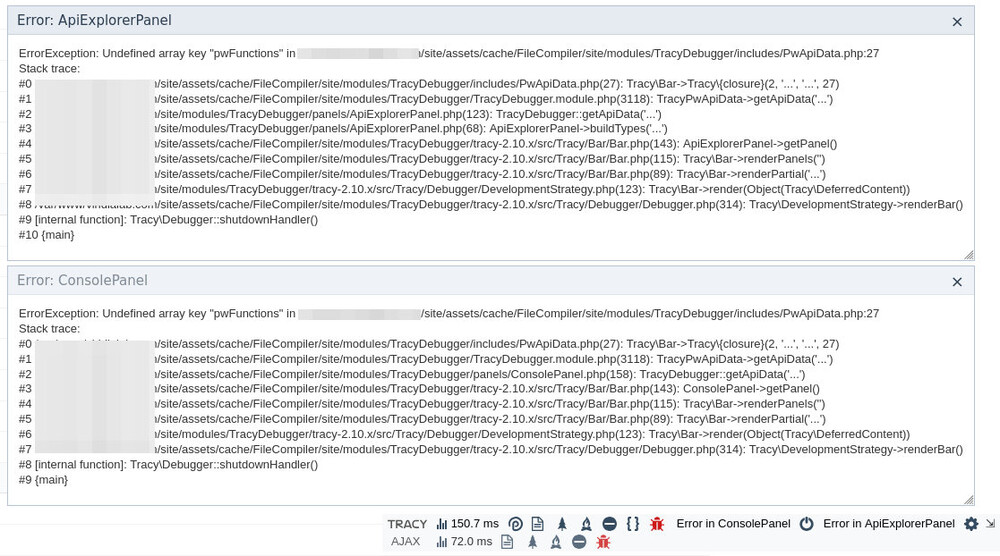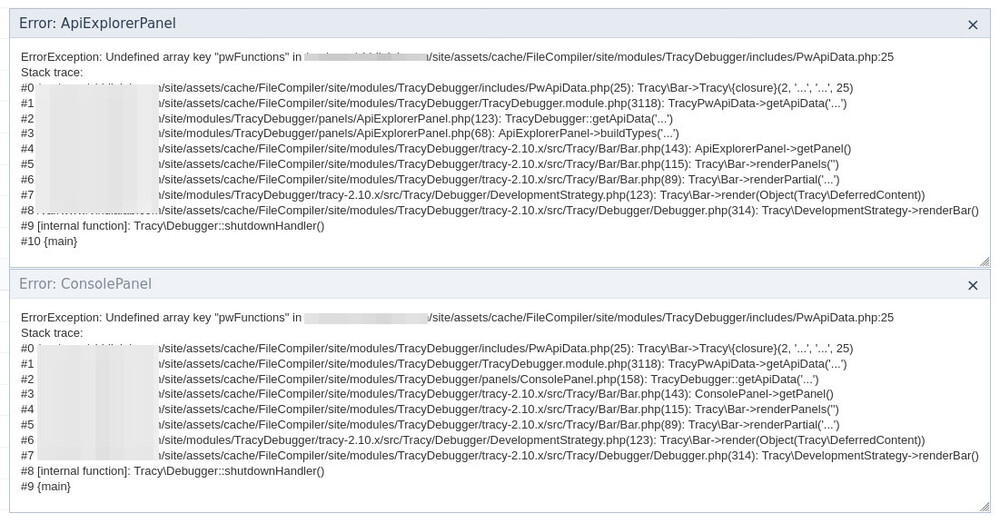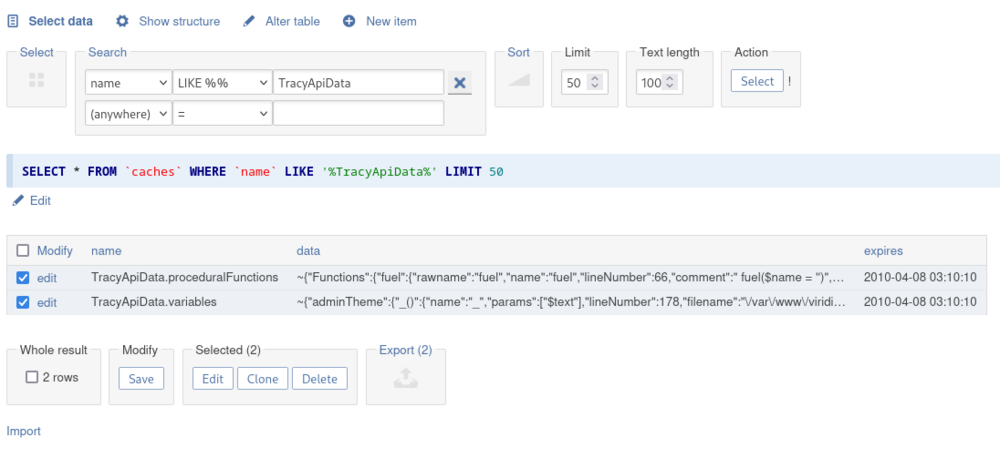-
Posts
651 -
Joined
-
Last visited
-
Days Won
6
Everything posted by rick
-
I am creating a module. The first-time install works without error, and the module functions without error. However, when I uninstall the module, then attempt to install the module again, I get the following error: "Unable to install module [module]: Role collision detected ([role]): role already exists." The role was deleted successfully, and no reference to that name exists in the database. Has anyone come across this before?
-
I appreciate that Jan. Works like a charm.
-
Two things first: 1) My searches returned no results for this issue. 2) I don't use github so I do not know how to submit a possible issue. So I would like to ask the community if I have either made a mistake (which is most likely) or have an actual issue; In which case I hope one of you more familiar with github can submit this as an issue. I've create a user profile page whereby the user can upload an avatar image. It works to the point of actually saving the image file in the correct location with the correct filename, but does not assign that to the image field due to the issues noted later. This is the code: ... $upload_path = wire()->config->paths->assets . "files/avatar_uploads/"; if(!is_dir($upload_path)) { if(!wireMkdir($upload_path)) throw new WireException("No upload path!"); } try { $user->first_name = $first_name; $user->last_name = $last_name; $user->user_bio = $user_bio; $user->share_bio = $share_bio; $files = new WireUpload('avatar'); $files->setDestinationPath($upload_path); $files->setTargetFilename($user->name."-avatar"); $files->setValidExtensions(['jpg','jpeg','png']); $files->setOverwrite(true); $file = $files->execute(); //returns array of uploaded filenames if($files->getErrors()){ foreach($file as $filename) @unlink($upload_path.$filename); ... } $user->avatar->removeAll(); $user->avatar = $upload_path.$file[0]; ... $user->save(['quiet'=>true]); The result of which issues two messages: I 've changed the WireUpload.php (I know, but it was a fast fix) to the following: protected function getTargetFilename($filename) { if(!$this->targetFilename) return $filename; // Parse incoming filename $pathInfo = pathinfo($filename); $extension = isset($pathInfo['extension']) ? $pathInfo['extension'] : ''; // Parse the set targetFilename $targetPathInfo = pathinfo($this->targetFilename); $targetExtension = isset($targetPathInfo['extension']) ? $targetPathInfo['extension'] : ''; // Strip off the target’s extension (if any) $base = basename( $this->targetFilename, $targetExtension !== '' ? '.' . $targetExtension : '' ); // Re‑append the incoming file’s extension (if any) return $base . ($extension !== '' ? '.' . $extension : ''); } This runs on Debian 12 Apache2, ProcessWire 3.0.246 Master, php8.4 if it matters. Thanks for your help!
-
@adrian I did a fresh install on localhost and Tracy runs just fine, so there must be something with my server. Although my localhost setup is the same as the server. I'm going to mark this thread as solved.
-
Thanks @adrian! Just an FYI... My server has php tokenizer installed and accessible. Debian 12, php 8.3, mysql 15.1, and apache 2.4 installed Nov '24. I completely uninstalled Tracy, deleted all Tracy related files from the server, and removed all references to Tracy in the DB. I installed Tracy from Modules > New. The Tracy Bar is not displayed at the bottom right of the screen. I went back into Tracy settings and selected the Force superusers into DEVELOPMENT mode. <-- I read somewhere on here about that setting. I submitted that change. The Tracy bar now shows at the bottom right but still displays the previous two errors. I unchecked the Force superuser checkbox and submitted that change. The Tracy bar disappears.
-
It obviously has to be something on my end. You don't need to spend time troubleshooting it since Tracy is just reporting the problem and not failing herself. When I get it sorted, I'll post back. I appreciate your help! Rick
-
Ok, I made the change in PwApiData.php } elseif ($type == 'proceduralFunctions') { $proceduralFunctionsFunctions = $this->getProceduralFunctions('Functions'); $apiData = array('Functions' => isset($proceduralFunctionsFunctions['pwFunctions']) ? $proceduralFunctionsFunctions['pwFunctions'] : array()); if (file_exists($this->wire('config')->paths->core . 'FunctionsAPI.php')) $apiData += array('FunctionsAPI' => $this->getProceduralFunctions('FunctionsAPI')['pwFunctions']); /* elseif($type == 'proceduralFunctions') { $apiData = array('Functions' => $this->getProceduralFunctions('Functions')['pwFunctions']); if(file_exists($this->wire('config')->paths->core . 'FunctionsAPI.php')) $apiData += array('FunctionsAPI' => $this->getProceduralFunctions('FunctionsAPI')['pwFunctions']); */ } ... Cleared DB cache, Refreshed modules, Restarted PW and got the same errors...
-
-
-
Sure thing! Gimme a sec...
-
ProcessWire 3.0.244 PHP 8.3.19
-
lol. You are correct, Sir! This is where I would have told you. 😄 The same error is present. I logged out and shutdown PW and logged back in.
-
Howdy @adrian, I don't know what the previous version was. It was a recent install within a month though. I removed these two resulting rows.
-
Howdy Adrian, I just upgraded to v4.26.67 in an attempt to fix a console error in the previous version. However this new error is different from the last. I read through the earlier post by nurkka, November 19, 2024 but your suggestions there did not resolve my issue. My original error suddenly appeared this morning after logging into the admin. "Error in ConsolePanel" is displayed in the debug bar. Everything was fine last evening before I logged out. This morning after logging in I noticed the error. I followed your suggestions from the post above without affect. After upgrading Tracy to this new version I now get the following error: Undefined array key "pwFunctions" in .../site/assets/cache/FileCompiler/site/modules/TracyDebugger/includes/PwApiData.php:25 This error is different from my original error which referenced a different file -- Sorry I don't have that exact filename as I deleted the cache as one of my troubleshooting steps. I believe it was the cached phpconsole file. Please let me know what additional information you need from me. Thanks! Rick
-
Shoutout to @matjazp! Thanks for all your help!
-
You can check out the blog module. It will handle the article content and related info. As far as the front-end looking like other magazine layouts, there are numerous free magazine html/css templates and more paid templates. You may want to consider a paid template. The free templates look like free templates. ?
-
Basically reiterating @wbmnfktr a Table is semantic while the DIVs are not. There a quite a few google search results for css div tables dating back to '08 where others have attempted replicating the html table using div elements. The main issue nowadays is the device screen sizes. Tables don't scale well at different resolutions. That being said, css has display:table, display:table-row, and display:table-cell type attributes, as well as using pseudo selectors like :last-child to reference specific elements. You could also hide specific table columns at different resolutions. I know this isn't the answer you were looking for, but maybe it helps with segregating large datasets into manageable chunks.
-

Payment related Project, opinions, hints, all much appreciated
rick replied to olafgleba's topic in General Support
Hello @olafgleba , What a fun project to work on. Reading through your post a couple of times it is clear you have everything under control, but simply have a question about processing payments for this parent (registration) -> child (art schools) relationship. First, I have no experience with padloper or formbuilder to say whether they can handle multiple vendors with multiple products. I'll leave that for the more experienced members. Lastly, I would contact stripe support and ask them the best means to handle multiple merchant accounts from a single URL (registration). This is where I think issues will arise. Normally you would define a single URL in the merchant account setup. But your solution would mean that you (registration) would also provide one or more merchant ids for each transaction. Stripe support will be able to answer that. I hope this helps. Also, keep us posted on this project (if allowed). -
Typography is not a simple topic but I'll try to explain how I use it. But first, the difference between EM/REM. Generally, an EM got it roots in print where it refers to the width of the upper-case M. When css came about, they changed it to refer to a relationship of the parent element. By default, one EM generally is 16 pixels in the browser world. The REM (Root EM) is in relation to the root (usually the HTML definition if no ::root{} is defined) font size as you have defined in CSS. Some inconsistency -- You can use both EM and REM in margin/padding definitions. However, when using EM as the unit in a margin definition it looks only at the current element; It does not refer back up to a parent. This is not the case with REMs. The REM declaration is always looking at the root. // EM html { font-size: 16px; } article { font-size: 20px; } p { font-size: 1.1em; margin-bottom: 1em; } <article> This is 20px. <p>This is 1.1 x 20px. The bottom margin is 1.1em regardless of parent font size setting.</p> </article> // REM html { font-size: 18px; } article { font-size: 20px; } p { font-size: 1.1rem; margin-bottom: 1rem; } <article> This is 20px. <p>This is 1.1 x 18px. The bottom margin is 1 x 18px.</p> </article> The viewport width/height (VW/VH) allows for a 'fluid' scaling. However, the drawback is that smaller devices will not zoom in or out should the font size scale too small. Also, on very wide screens this scaling would likely make the text way too big, to the point of interfering with other content. My method: I define my base font size as 16px (usually the browser default). I also include variables to make future changes very simple. I put my font size break points at the top of my css file (usually after ::ROOT{} ) so that I don't have to go hunting should I need to change something. To avoid the confusion between parent references, I define all font sizes, margins, paddings, widths, etc. in REMs, except for the base ::root{} definition which is in pixels. :root { --fs-norm: 1rem; // defaults to browser's font-size definition --fs-big: 2rem; --fs-hdg: clamp(3.5rem, 10vw + 1rem, 14rem); // This sets the min and max font-sizes and scales in between } @media (min-width: 40rem) { :root { --fs-norm: 1.125rem; --fs-big: 3rem; } } body { font-size: var(--fs-norm); line-height: 1.6; } h1 { font-size: var(--fs-hdg); text-transform: uppercase; } I hope this helps. Like I said, this isn't a simple topic where you can say, "Use x because...". ps. Not a front-end guru so others may have a better reply.
-
Maybe I'm off base here, but since you say the user is the issue, why not create your own ISAM routine by hooking the registration to it's own domain/database and passing the result to the proper installation login/user.
-

Should custom forms be built with the ProcessWire Form API?
rick replied to Jonathan Lahijani's topic in General Support
Personally, I prefer the old-school way rather than the ProcessWire way simply because it becomes too cumbersome to use ProcessWire to create Admissions forms, Tax forms, Milspec forms, Aircraft maintenance forms, etc. which I do almost monthly. I did begin with the ProcessWire way and spent way too much time trying to get the layout correct on both the front end and back end, so I stopped using its forms. As you know PHP has some built-in validation such as email, url, dns, etc. The remaining form types are simple enough to validate manually (ie, not using ProcessWire). Don't get me wrong, ProcessWire is great for the majority of solutions I require and I use it as the base for all current projects. But Ryan built it to satisfy his requirements, which don't necessarily meet with our requirements 100% of the time. When I create complex forms I use css grid and flexbox with custom styles to achieve the necessary front-end layout -- I don't allow user access to any back-end forms. Custom javascript is sometimes required to validate some form elements client side, including ajax calls, but it is nothing major. Also, I don't have to bloat my forms by including one or more third-party javascript libraries. If I receive a request for a simple form such as a contact form, then yes, I use the ProcessWire way. Otherwise, I find it much simpler to do it the old-school manual way. -

Add public / web directory to $config->paths
rick replied to SwimToWin's topic in Wishlist & Roadmap
The config->paths->root also contains the current process as part of the path. For example, if you are currently within a custom process module named 'widget', then the returned path is '/path/to/docroot/widget/'. You could use a combination of string functions with DOCUMENT_ROOT, CONTEXT_DOCUMENT_ROOT, and SCRIPT_FILENAME values to validate the directory. As far as I know, the script_filename value is not vulnerable so should provide a base from which to test and extract the doc root with some confidence. -
Wow! Thank you! I was hoping for a suggestion where to look, not a complete working example. That is the cool thing about you, @Robin S, you are always above and beyond anyone's request for assistance. Much respect!







